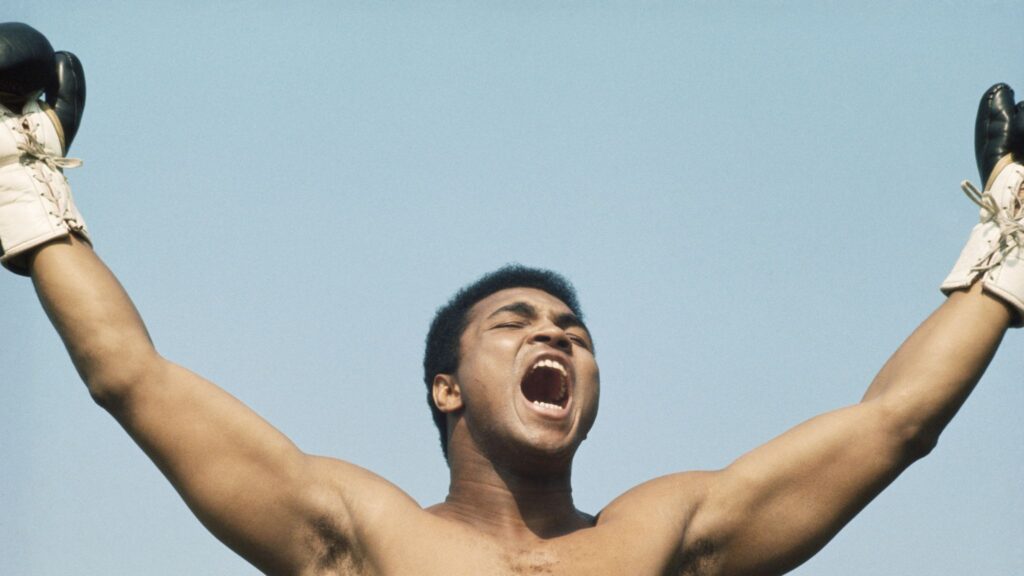Table of Contents
ToggleTop 10 Interesting and Fun Facts about Muhammad Ali
Born as Cassius Marcellus Clay Jr. on January 17, 1942, in Louisville, Kentucky, Muhammad Ali, an American professional boxer and activist, became one of the most legendary figures in sports history. Known by his nickname “the Greatest,” he is widely considered as the best heavyweight boxer of all time and one of the most important sports figures of the 20th century.

Ali held the Ring magazine heavyweight title from 1964 to 1970. He was the undisputed champion from 1974 to 1978 and the WBA and Ring heavyweight champion from 1978 to 1979. He was named the Sports Personality of the Century by the BBC and Sportsman of the Century by Sports Illustrated in 1999. After 1961, he became an Islamic convert. On February 25, 1964, at the age of 22, he upset Sonny Liston to win the world heavyweight championship. In that year, he formally changed his name to Muhammad Ali and rejected his birth name as a “slave name.”
Whether you’re a boxing enthusiast or just curious about one of the most iconic figures of the 20th century, this post will provide a deep dive into Ali’s life.
1. Muhammad Ali’s Boxing Career Was Started by His Bicycle
Muhammad Ali’s love of boxing was sparked by a stolen bicycle, which is one of the most fascinating tales about his early days in the sport. In Louisville, Kentucky, Ali’s birth name, Cassius Clay, had his red Schwinn bicycle stolen when he was twelve years old.
The youthful Clay was enraged and swore to “whup” the robber. He informed Joe Martin, a boxing trainer and local police officer, about the theft. Martin advised Clay to train as a fighter before seeking retribution. Clay followed this advice and joined a nearby boxing facility; the rest is history. One of the most amazing careers in sports history began with the incident.
It’s amazing to see how determined Ali was even as a young child to pursue justice for his stolen bike. For a man who would later “fight” for his beliefs both inside and outside the ring, it’s a fitting start.
2. After converting to Islam, Muhammad Ali Changed His Name
Muhammad Ali was born Cassius Marcellus Clay Jr., but changed his name in 1964 when he became an Islamist. After defeating Sonny Liston to win the World Heavyweight Championship for the first time, Ali declared his allegiance to the Nation of Islam. Elijah Muhammad, the group’s leader, gave him the name Muhammad Ali, which translates to “worthy of praise” and “exalted one.”
After changing his name, Ali became an ardent activist who utilized his position to support religious liberty and civil rights. Ali maintained his integrity in the face of strong criticism from the public and media, enhancing his reputation as a social justice pioneer. By changing his name, he was expressing his rejection of his “slave name” and taking a step toward accepting his status as a Black Muslim.
3. Ali allegedly Threw His Olympic Gold Medal into the River Despite Having Won it
Muhammad Ali, who was still going by Cassius Clay at the time, participated in the 1960 Summer Olympics in Rome, Italy, at the age of 18. Ali’s notable achievement that served as a springboard for his professional career was winning the gold medal in the light heavyweight boxing division. Nonetheless, one of the most well-known myths about Ali’s Olympic medal is that, after encountering racism in his native Louisville, he flung it into the Ohio River in a fit of rage.
Even while the story has been widely shared, others who are close to Ali maintain that it never happened. However, Ali frequently discussed his disappointment with racism in America, and this symbolic action played a significant role in his story. Regardless of the veracity of the incident, it highlights Ali’s ongoing struggle against racial injustice.
During the Atlanta Olympics in 1996, Ali received a replacement gold medal as a token of appreciation for his accomplishments and contributions to the sports industry.
4. Ali’s Well-Known Phrase “Float Like a Butterfly, Sting Like a Bee” Went Down in Legend
Muhammad Ali was well-known for his famous comments, poetic trash talk, and sharp wit. Possibly his most well-known quote, “Float like a butterfly, sting like a bee,” perfectly captured his distinct boxing technique: elegant footwork mixed with precise, potent blows. Ali frequently used rhyming remarks to tease his opponents, showcasing his charm and confidence.
Ali’s trainer Drew “Bundini” Brown is credited with coining the expression, which he shouted during Ali’s bout with Sonny Liston. It came to symbolize Ali’s tactical genius, showcasing both his dexterity and his capacity to deal lethal blows to his adversaries.
Ali was a larger-than-life character because to his ability to amuse fans and promote his fights with linguistic abilities as keen as his physical ones. His unique combination of talent and showmanship in the boxing world was unmatched.
5. Muhammad Ali Refused to Serve in the Vietnam War
The year 1967 marked one of the most contentious periods in Muhammad Ali’s life when he declined to enlist in the American Army during the Vietnam War. Ali famously said, “I ain’t got no quarrel with them Viet Cong.” He also mentioned his opposition to the war and his Nation of Islam religious beliefs. Due to his unwillingness to serve, he was found guilty of evading the draft, fined $10,000, and had his boxing titles revoked.
During the height of his career, Ali was prohibited from boxing for three years; during that time, he rose to prominence in the civil rights movement and became a symbol of resistance to the war. He lost millions of dollars as a result of his position, yet he never wavered in his beliefs.
After his conviction was reversed by the US Supreme Court in 1971, Ali made his way back into the ring and proceeded to create history there.
6. The match between Ali and George Foreman is referred to as “The Rumble in the Jungle”
The 1974 fight between Muhammad Ali and George Foreman, which is considered one of the greatest boxing contests ever, happened in Kinshasa, Zaire (now the Democratic Republic of the Congo). This match, which was dubbed “The Rumble in the Jungle,” demonstrated Ali’s amazing stamina and strategy. Because of his overwhelming strength and tendency to finish fights, Foreman—who was the heavyweight champion at the time—was regarded as the favorite.
But Ali also invented the “rope-a-dope” tactic, when he leaned back against the ropes and let Foreman take all the punches in the world. Relatively fresh, Ali seized command of the bout in the latter rounds and stopped Foreman in the eighth to win back the World Heavyweight Championship.
Ali’s triumph cemented his reputation as a boxing icon and illustrated both his cerebral fighting style and his capacity to triumph against overwhelming odds.

7. Parkinson’s disease affected Ali
Muhammad Ali received a diagnosis of Parkinson’s disease, a movement-impairing neurological condition, in 1984. Many people think that Ali’s illness was brought on by the numerous head injuries he had throughout his boxing career. Ali was involved in the public eye for many years after receiving the diagnosis, utilizing his position to advocate for research initiatives aimed at finding a cure and to increase public awareness of Parkinson’s disease.
The bravery Ali displayed in the ring was matched by his courage in fighting his illness. His spirit remained unshakable despite his physical decline, and he never stopped inspiring people all around the world.
When Ali lit the Olympic cauldron during the Atlanta Games in 1996, it became a legendary gesture that represented his unwavering fortitude and perseverance in the face of hardship.
8. Ali was named the “Sportsman of the Century” by Sports Illustrated
Muhammad Ali was named the “Sportsman of the Century” by Sports Illustrated in 1999 in honor of his significant influence on the sports industry and his societal contributions. This distinction was given at a time when many who had previously condemned Ali for his activism and political ideas were reevaluating his legacy.
Ali became more than just an athlete thanks to his charm, talent, and social engagement; he became a cultural icon who went beyond athletics. His impact would endure well beyond his time in the ring because of his capacity to motivate others from all walks of life.
Not only did Ali win the Sports Illustrated title, but he was also named the “BBC Sports Personality of the Century,” which cemented his reputation as one of the greatest sportsmen of all time and widespread popularity.
9. Muhammad Ali Loved Magic Tricks
Performing magic tricks was one of Muhammad Ali’s numerous pastimes outside of the ring. He was well-known for using sleight of hand, card tricks, and other magical shows to delight his audience, friends, and family. In addition to enhancing his legendary reputation, Ali’s fascination with magic revealed a different aspect of his lively personality.
Ali’s passion for magic demonstrated his lighthearted demeanor and his capacity to enthrall spectators both inside and beyond the arena. Ali understood how to put on a show, whether he was entertaining a small group of people or millions of fans.
10. Ali Participated in the First Battle Called “The Battle of the Century”
Joe Frazier and Muhammad Ali squared off in what was dubbed the “Fight of the Century” on March 8, 1971. It was the first time two unbeaten heavyweight champions squared off, and it happened at Madison Square Garden in New York. Ali was trying to reclaim the title against the current champion, Frazier, having had his titles revoked for refusing to fight in the Vietnam War.
The boxers put on an exciting show, and the battle lived up to its moniker. After 15 exhausting rounds, the fight was decided by unanimous decision. Ali was knocked down with a stunning left hook in the last round. Even in the face of defeat, Ali’s bravery and tenacity won him the admiration of both supporters and detractors.
Two more fights between Ali and Frazier would follow, with Ali emerging victorious in both, including the well-known “Thrilla in Manila” in 1975, which is regarded as one of the best boxing contests of all time.

